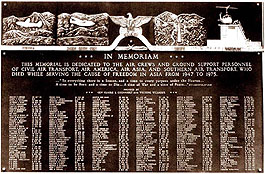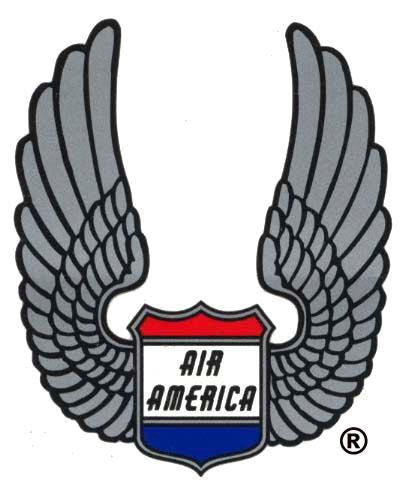Memorial Plaque
Memorial Dedication - McDermott Library, University Of Texas At Dallas - May 30, 1987
Eulogy provided by Mr. Jerry Fink, former deputy legal council of CAT, Air ASIA, and Air America.
It was with some hesitation that I accepted the task of delivering the eulogy for 242 people because many of them were not known to me personally. Their death or disappearance had occurred over a period of three decades and they represented six different cultural backgrounds. In addition, another decade has slipped by since the door closed on the events which bring us together here today. In such circumstances, I wondered how should one begin.
 |
| |
There is a common thread which connects each name on the Honor Roll being dedicated. At the time each person died or was declared missing in action, they were employed by an aviation complex best known collectively as "Air America" or "CAT." That common thread has continued and connects the past to the present. Many past employees here today are members of the Air America Club which initiated this memorial effort, the CAT Association, or both. With the assistance of the McDermott Library and the University of Texas at Dallas, we members of the two organizations, along with the families, friends and relatives of those being honored are ensuring that this common thread shall serve as a connection to the future.
We have undertaken to do this so that none of those who died or disappeared shall be forgotten. That none of them, in the words of Sir Walter Scott, shall be "unwept, unhonored and unsung". The cause of freedom for which they gave so much shall be continued in their names.
"To everything there is a season and a time to every purpose under heaven." The time to honor those who died or disappeared is Now, Today, at this dedication ceremony.
- We honor them for the courage of their convictions supporting foreign Wars where democracy and freedom of the individual were being challenged;
- We honor them for the devotion to duty required working side by side with citizens of countries who were fighting a losing battle to keep their lands free, often under substandard conditions and in hostile situations;
- We honor them for the humanity they displayed in supporting the efforts to provide food and evacuation for people whose lives were threatened;
- We honor them for serving the cause of freedom as civilians during which their death or disappearance occurred with the same finality as their uniformed comrades;
- We honor them for their loyalty to their countries and to the company for which they worked;
- Finally, we honor them because they may not otherwise be honored publicly by the United States Government and the Central Intelligence Agency which was their ultimate Employer and for whom they made the supreme sacrifice serving the cause of freedom.
Freedom has always been a most sought after goal by those under the yoke of domination. Many misguided people spoke out against, and will continue to speak out against the type of activity for which our fellow employees gave their lives. Our actions here today will ensure that each name will serves as a inspiration to future generations who believe as they did. Each name stands as a tribute to the cause of freedom. To be well thought of after death is the highest form of praise. To insure the success of this eulogy, I ask each of you to participate in a minute of silence to remember and honor in your own way the dead and missing whom you knew.
President Ronald Reagan - May 5, 1987
It gives me great pleasure to greet everyone gathered for the Air America Club’s 1987 reunion, and to dedicate a memorial for the pilots and associates of Air America who died in the line of duty in Asia during 1947-1975.
Each of you has gone his separate way in the world, but as this reunion shows once again, the unique service you shared in defense of freedom forged a bond of brotherhood that time and distance cannot break. Unsung and unrecognized, each of you confronted danger and endured terrible hardships, and each of you rose to the challenge; you never faltered. Although free people everywhere owe you more than we can hope to repay our greatest debt is to your companions who gave their last full measure of devotion. Just as their names are inscribed on this memorial, so their memories are inscribed in our hearts. We will never forget them or their families, some of whom still seek answers.
I send a special salute to all those members of Air America present, and reaffirm my Administration's pledge to obtain the fullest possible accounting on the fate of our missing in action. You have my best wishes. God bless you, and God bless America.
William P. Clements, Jr. - May 1, 1987
It is my pleasure to send greetings to the Air America Club's reunion on this special occasion.
It is important to the health and welfare of our nation to remember those veterans and volunteers who answered the call of duty. A nation cannot ask more of any citizen than to risk his or her life for the country's preservation.
In Southeast Asia, 242 American civilians lost their lives between 1948 and 1975 flying supply and other missions for the U.S. Government. The conditions and equipment with which they worked were never the best, yet they never gave up in the fight for freedom.
It is with thanks and gratefulness that I offer my best wishes to the surviving members of their families. It is high time that these brave individuals be honored, and there is no better place than the McDermott Library's aviation section.
Remarks of Dr. William Leary, Professor of History,
University of Georgia, Athens, GA.
When Princeton University acquired the papers of Whitey Willauer in 1967, I had little idea that my curiosity about their contents would lead to a scholarly project that would last twenty years-and is not yet finished. Over the past two decades, I have learned a great deal about an extraordinary group of individuals who took part in a truly unique aerial adventure.
The story of Air America began in 1947 when two talented and adventurous men-Gen. Claire Chennault and Whitey Willauer - started a small airline in postwar China. They called it CNRRA Air Transport, and they hauled relief supplies throughout the country. After a year of hauling United Nations cargo they got a commercial contract and changed the name of the airline to Civil Air Transport--CAT--and they began operating throughout the country on a commercial basis. They never had much money, operating conditions were always difficult, but they had innovation and dedicated personnel-and they had what Gen. Chennault like to call "the CAT spirit"-which I think has been a central part of the organization ever since.
By the end of 1948, CAT was deeply involved in China's civil war. CAT evacuated more than 100,000 desperate people from
the doomed city of Mukden in Manchuria. They brought in supplies and carried out wounded during the epic battle of Hsuchow. In one of the most heroic and least known airlifts in history, CAT flew long missions to Taiyuan, supporting Marshal Yen His-shan in his struggle against the communist.
CAT retreated to Taiwan during the winter of 1949-1950, broke economically but with its precious assets of aircraft,
personnel, and spirit intact. Shortly thereafter, the airline changed ownership. Not many people knew about it at the time-and
some even later-because the new owner very mush preferred to remain a silent partner in this enterprise. Only much later did it become clear that the Central Intelligence Agency had acquired the first of what became a worldwide network of air
proprietaries.
CAT went to work for the CIA during the 1950's first during the Korean war, latter throughout the far east-and beyond. The
CIA used CAT to deliver weapons to anti-Communist elements in Burma, to support guerrilla operations on the Chinese mainland and in Manchuria, and on a variety of convert operations. CAT pilots flew through the flak filled skies of Dien Bien Phu in 1954 in a valiant but doomed effort to support the besieged French garrison. CAT was in Guatemala in 1954. CAT was in Indonesia in 1958. CAT personnel were at the Bay of Pigs. And in some of the most demanding and successful long range missions ever undertaken by the airline, CAT supported a major CIA project in Tibet for many years.
Despite the wide range of activities, CAT remained a fairly small operation during the 1950's, but the 1960's brought a major change. As the United States expanded it's commitment to Southeast Asia in the variety of diplomatic and political factors, Air America soon found itself at the center of a secret war in Laos. Air America aircrews hauled refugees and rice-lots of rice-ammunition and troops through Laos; they inserted and extracted reconnaissance teams under extremely hazardous
conditions; they airdropped supplies out of C-130ås, C-123ås, C-46ås, B-26's, and a variety of other aircraft. They landed
Helios and Porters on tiny strips carved out of mountain tops. And they undertook very, very difficult search-and-rescue
missions with unsurpassed bravery and skill.
Air America became a legend in Laos. Although sometimes scorned by outsiders as mercenaries the aircrews earned high praise from the "customers" As one CIA case officer has recently written to me, "I have seen Air America pilots stay on runways under attack, waiting until they got all the people on board, delaying takeoff at considerable risk to themselves. They have made drops under hostile conditions when the normal thing to do would have been to return and try again. No military service excelled this group of people in dedication, or loyalty, or valor.
Air America personnel where in Thailand, working with the Border Police, training Thai pilots and technicians, performing maintenance work, and flying convert missions out of a secret base at Takli. Personnel of the air complex could be found
throughout the region, from Phnom Penh to Chiengmai to Katmandu. Air America supported the United States effort in Vietnam. It was at the beginning, carrying refugees and CIA agents between Hanoi and Saigon in 1954. And it was there at the end. Indeed, the most enduring vision of the final act in Vietnam is that dramatic photo of an Air America helicopter loading passengers atop the Pittman Apartments.
Air America, under the guise of Air Asia, operated a superb maintenance complex at Tainan on Taiwan, serving both it's own
needs and doing important contract work for the military. Southern Air Transport, another component of the Air America
complex, carried military personnel throughout the Far East, and stood ready to provide heavy airlift for CIA projects when
necessary.
At its peak during the late 1960's, the air complex employed more than 8,000 people.
Looking back on it, I have been impressed by that fact that all-or most-shared a common characteristic. The captains of the
Mandarin Jet; fixed and rotary wing pilots; flight engineers; flight mechanics; flight attendants; air freight specialists and
dispatchers; operations, maintenance and administration personnel; the people who shinned the C-46's until they sparkled; Americans, Chinese, Thai, Lao, Vietnamese, Japanese, Korean, Filipino, and other nationalities-they were dedicated
professionals.
And they did a superb job, these dedicated professionals of CAT and Air America. But the cost often war high, which is why
we are here today-to honor those individuals who lost their lives while serving the cause of freedom.
It is appropriate, I believe, that they have their special place, apart from the great memorial in Washington. They were after all a unique group of individuals-the secret soldiers of the cold war.





